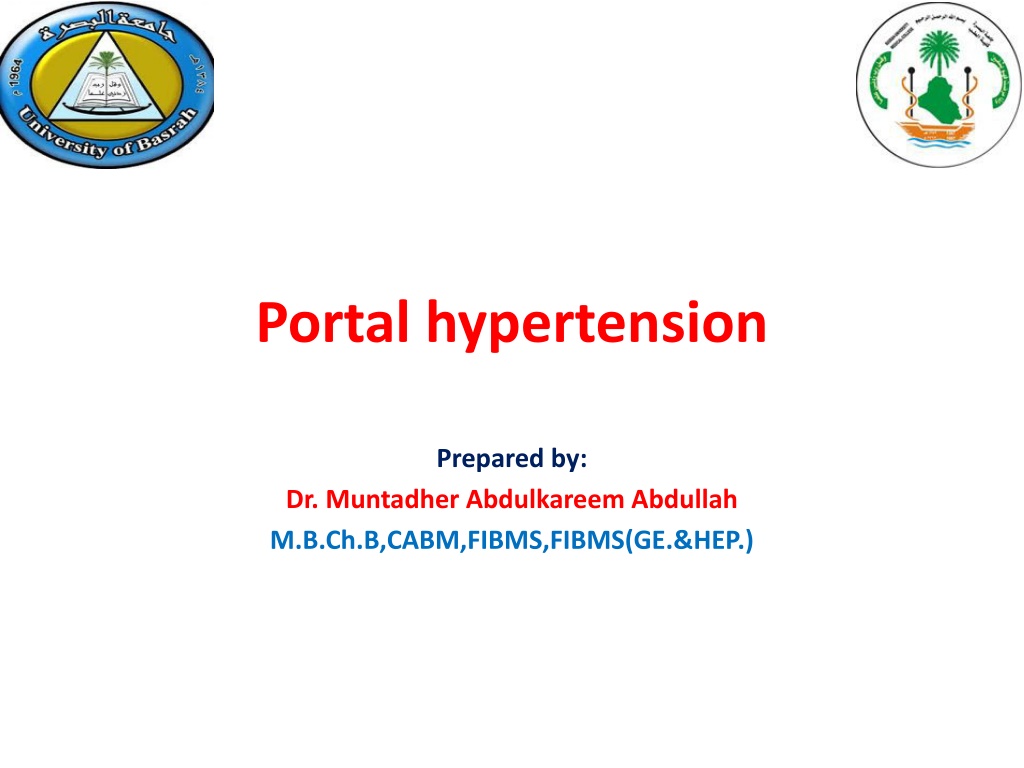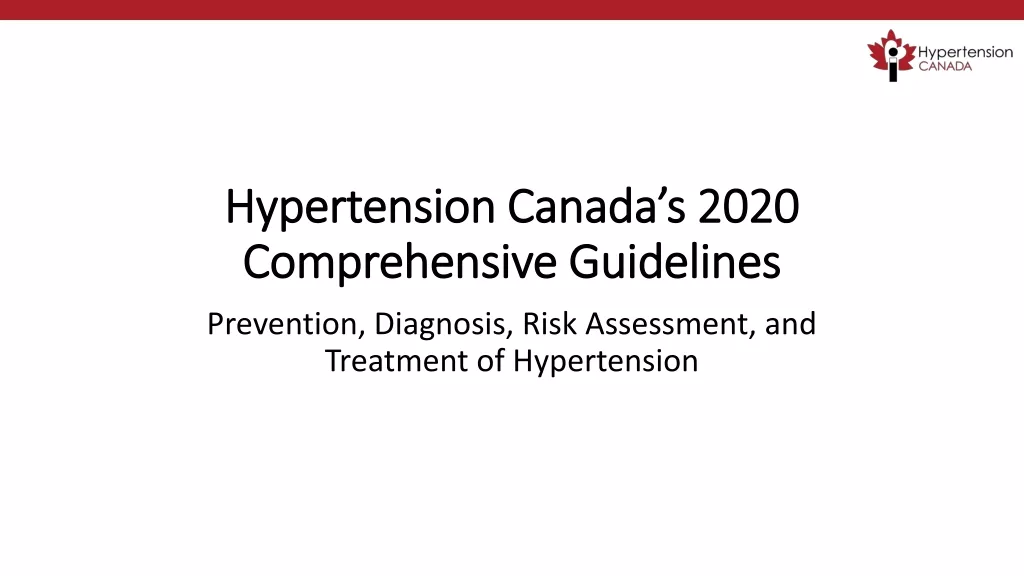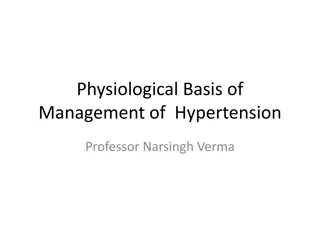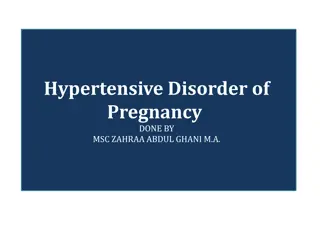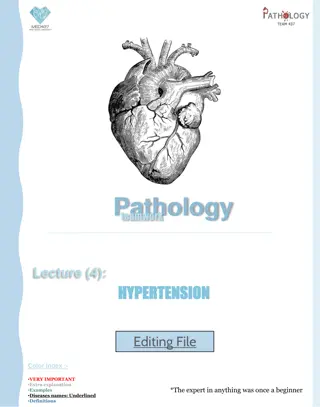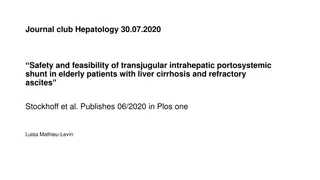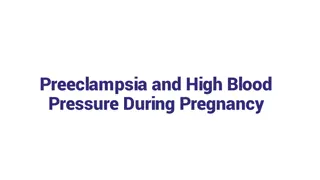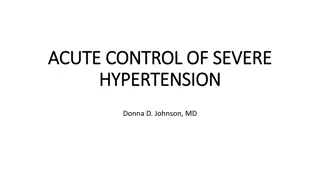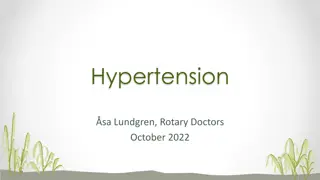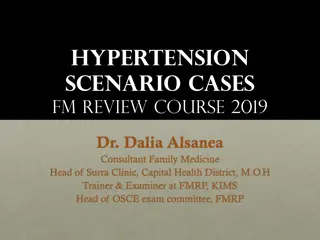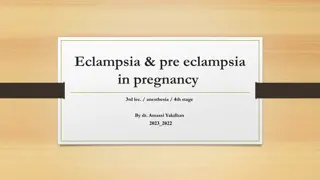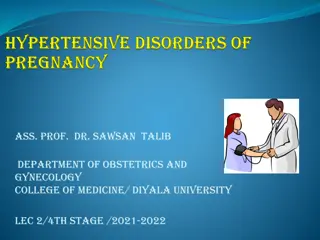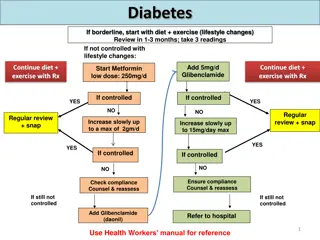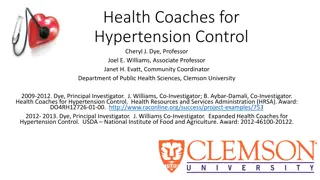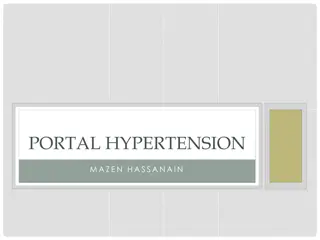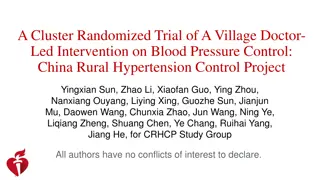Understanding Portal Hypertension: Causes, Symptoms, and Management
Portal hypertension is a condition characterized by increased pressure in the portal venous system, leading to serious complications like variceal bleeding. This article covers the definition, causes, and classification of portal hypertension. Learn about its manifestations, diagnostic approaches, and management strategies through a series of clinically relevant questions. Enhance your knowledge of this complex condition to improve patient care and outcomes.
Download Presentation

Please find below an Image/Link to download the presentation.
The content on the website is provided AS IS for your information and personal use only. It may not be sold, licensed, or shared on other websites without obtaining consent from the author. Download presentation by click this link. If you encounter any issues during the download, it is possible that the publisher has removed the file from their server.
E N D
Presentation Transcript
Portal hypertension Prepared by: Dr. Muntadher Abdulkareem Abdullah M.B.Ch.B,CABM,FIBMS,FIBMS(GE.&HEP.)
Objectives: At the end of this lecture you must know: 1.What is portal hypertension ? 2.What is etiology of portal hypertension ? 3.What are manifestation of portal hypertension? 4. Lines of Manegments of portal hypertension ?
At the end of this lecture , you must be able to answer these questions easily ? Q1 : A 40-year-old man with long-standing alcohol abuse complains of abdominal swelling, which has been progressive over several months. He has a history of gastrointestinal bleeding. On physical examination, there are spider angiomas and palmar erythema. Abdominal collateral vessels are seen around the umbilicus. There is shifting dullness, and bulging flanks are noted. Which of the following is the most important first step in the patient s evaluation? A. Diagnostic paracentesis B. Upper GI series C. Ethanol level D. CT scan of the abdomen E. Echo study
Q2 :The following precipitate portasystemic encephalopathy: A. Hypernatremia B. Hypocalcaemia C.Hypophosphtemia D.Hypokalemia E. Hyperkalemia
Q3 : 56 year old male patient with history of chronic hepatitis B virus infection, presented with progressive abdominal distension and jaundice, the patient is known case of bronchial asthma Investigation shows: Total S.bilirubin=4mg/dl mainly direct s.creatinin=1.7mg/dl S.sodium=132mmol/l INR=1.8 s.albumin=2.9g/l Abdominal uls=cirrhotic liver with moderate amount of ascites OGD done show large oesophageal varices Regarding primary prophylaxis of oesophageal varices, what is the best next step? A. Initiate non selective B-blocker B. Start endoscopic band ligation program C.Refer patient for TIPS D.Refer patient for shunt surgery E. Initiate selective B-blockers
Definition of portal hypertension Portal hypertension (PHT) indicates increased pressure in portal venous system. Normal portal venous pressure is 10 mmHg (14 cm of H2O). The normal hepatic venous pressure gradient (difference between the wedged hepatic venous pressure (WHVP) and free hepatic venous pressure is 5 6 mmHg. Clinically significant portal hypertension is present when the gradient exceeds 10 mmHg and risk of variceal bleeding increases beyond a gradient of 12 mmHg.
Classification and causes of portal hypertension : Classification Site of block Example 1. Pre hepatic Pre sinusoidal Extra hepatic portal venous obstruction (EHPVO) 2. Intrahepatic a. Pre sinusoidal Non cirrhotic portal fibrosis (NCPF) Schistosomiasis Cirrhosis b. Sinusoidal c . post sinusoidal venooclusive disease 3. Post hepatic Post sinusoidal Hepatic venous outflow tract obstruction (HVOTO) Budd Chiari syndrome Constrictive pericarditis
Clinical features of portal hypertension : 1.GI Bleeding : The most important, dreaded and dramatic presentation of PHT is GI bleeding and is the commonest reason for patients to visit a hospital. Bleeding is spontaneous, profuse, and painless. Most of the time bleeding is from esophageal varices. In about 2-10% cases the bleeding may be from gastric varices.
2. Splenomegaly : is present in all cases of PHT The splenic enlargement is maximal in cases of NCPF. The cirrhotics may have only minimal enlargement of spleen with PHT. The spleen may regress in size after a recent bleed. These patients may have associated hypersplenism and therefore may require surgical intervention. Mild hypersplenism as manifested by thrombocytopenia and leucopenia is seen in 40-80% of patients and may require splenectomy.
3. Ascites SAAG>=1.1 indicates hepatic decompensation. A prominent feature in HVOTO, it is rarely seen in patients with EHPVO but may be seen in about 10% cases of NCPF Presence of ascites also makes interventional investigations like a liver biopsy e a dangerous affair as the tamponade action of abdominal wall after the puncture of liver is not possible in presence of ascites.
4. Portosystemic encephalopathy defined as an abnormality of brain function due to disease of liver and is a sign of liver decompensation. Early symptoms of encephalopathy are subtle but can be identified by bedside tests like changes in hand writing, inability to copy a five pointed star, Reitan number connection test etc As the severity of encephalopathy increases, patient passes into deep coma. 5. . Signs of liver failure may be apparent in cirrhotics like palmar erythema, gynecomastia, spider naevi and loss of axillary and pubic hair.
Investigations Investigations will depend upon the situation in which patient is seen. They are grouped under the following situations: 1. In an elective situation: a. Hematology : especially to look for any evidence of hypersplenism. b. Liver function tests to differentiate cirrhotic from non cirrhotic portal hypertension and to classify them as per Child-Pugh classification c. Coagulation profile d. Viral markers
e. Liver biopsy : especially to ascertain the etiology of cirrhosis. For this patient should not have ascites and should have corrected coagulation parameters. f. Upper GI endoscopy : for documentation and grading of esophageal varices, gastric varices, any PHT gastropathy and any other cause of hematemesis. g. USG : is done to demonstrate collaterals in splenic hilum and elsewhere, to see the echotexture of liver, to look for any ascites and also to assess splenic vein and left renal vein as a pre operative evaluation. h. Spiral CT angiography: gives a good picture of portal venous system and collaterals. This information is useful if a surgical procedure is being contemplated. i. MR Angiography: gives similar information as CT, however it delineates intravenous thrombosis better hence this investigation is very useful in a condition like Budd e Chiari syndrome.
2. In an emergency situation: Clinical examination for splenomegaly is sometimes more than enough in a situation of massive GI bleeding, to diagnose PHT. a. Upper GI endoscopy is required more as a therapeutic procedure than a diagnostic procedure in such conditions. b. Liver function tests are required to assess condition of liver to differentiate from cirrhotics done c. USG abdomen as a quick bedside assessment of liver and portal venous system is quite informative and should be
Management Mere presence of PHT is not an indication for an active treatment other than simple supportive measures, and this include : Treatment of Acute upper gastrointestinal haemorrhage from gastrooesophageal varices and portal hypertensive gastropathy Treatment of ascites Treatment of hypersplenism Treatment of portosystemic encephalopathy Liver transplant in cirrhotic patient Primary prevention of variceal bleeding: if non-bleeding varices are identified at endoscopy: -adrenoceptor antagonist ( -blocker) therapy with propranolol (80 160 mg/ day) or nadolol (40 240 mg/day) is effective in reducing portal venous pressure. Carvedilol, a non-cardioselectivevasodilating -blocker, is also effective and may be better tolerated at doses of 6.25 12.5 mg/day) Endoscopic variceal band ligation
Management of acute variceal bleeding: Rescistation with blood and plasma The source of bleeding should always be confirmed by endoscopy because about 20% of patients are bleeding from non-variceal lesions All patients with cirrhosis and gastrointestinal bleeding should receive prophylactic broad spectrum antibiotics, such as oral ciprofloxacin or intravenous cephalosporin or piperacillin/tazobactam, because sepsis is common and treatment with antibiotics improves outcomes The measures used to control acute variceal bleeding include: vasoactive medications (e.g. terlipressin) endoscopic therapy (banding or sclerotherapy) balloon tamponade, TIPSS and rarely, oesophageal transection Proton pump inhibitor to prevent peptic ulcer Phosphate enema and/or lactulose to prevent hepatic encephalopathy
Secondary prevention of variceal bleeding: Beta-blockers are used as a secondary measure to prevent recurrent variceal bleeding Following successful endoscopic therapy, patients should be entered into an oesophageal banding programme with repeated sessions of therapy at 12 24-week intervals until the varices are obliterated In selected individuals, TIPSS may also be considered in this setting
Congestive portal hypertensive gastropathy: Long-standing portal hypertension causes chronic gastric congestion Recognizable at endoscopy as multiple areas of punctate erythema ( portal hypertensive gastropathy or snakeskin gastropathy ) Rarely, similar lesions occur more distally in the gastrointestinal tract These areas may become eroded, causing bleeding from multiple sites Acute bleeding can occur but repeated minor bleeding causing iron defciency anaemia is more common. Anaemia may be prevented by oral iron supplements but repeated blood transfusions can become necessary. a TIPSS procedure can be undertaken. Reduction of the portal pressure using propranolol (80 160 mg/day) is the best initial treatment. If this is ineffective,
Manegments of ascites : Low sodium diet <2 gram /day to more restrictive sodium intake of 100 mmol/24 hrs ( no added salt diet ) Restriction of water intake to 1.0 1.5 L/24 hrs. is necessary only if the plasma sodium falls below 125 mmol/L Potassium sparing diuretic (spironolactone 100-400 mg/day), loop diuretic (frusemide up to 160mg/day) Large volume paracentesis TIPPS Liver transplant
Treatment of hypersplenism : Splenectomy if non cirrhotic PHTN Splenectomy with shunt procedure if cirrhotic PHTN Liver transplant
Manegments of portosystemic encephalopathy Treatment of precipitating cause Dietary protein restriction is rarely needed and is no longer recommended as first-line treatment because it is unpalatable and can lead to a worsening nutritional state in already malnourished patients suppress the production of neurotoxins by bacteria in the bowel with : Lactulose (15 30 mL 3 times daily) is increased gradually until the bowels are moving twice daily. Rifaximin (400 mg 3 times daily) Chronic or refractory encephalopathy is one of the main indications for liver transplantation
Factors precipitating hepatic encephalopathy: Drugs (especially sedatives, antidepressants) Dehydration (including diuretics, paracentesis) Portosystemic shunting Infection Hypokalaemia Constipation Protein load (including gastrointestinal bleeding)
